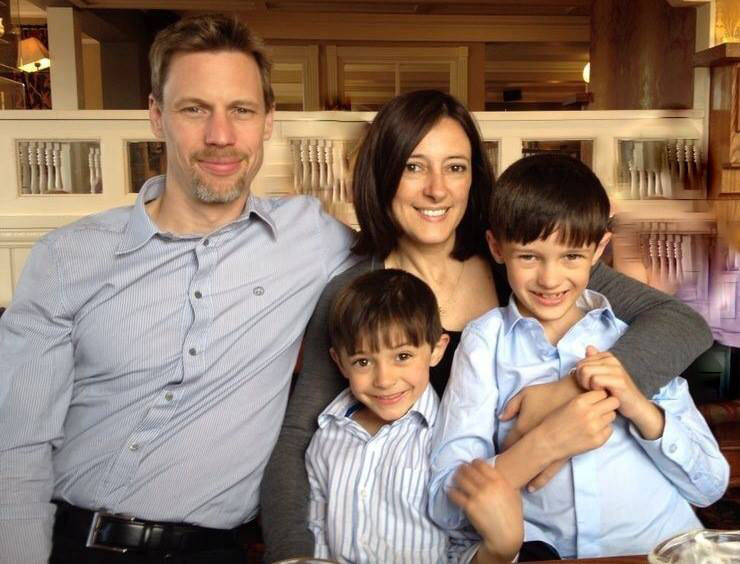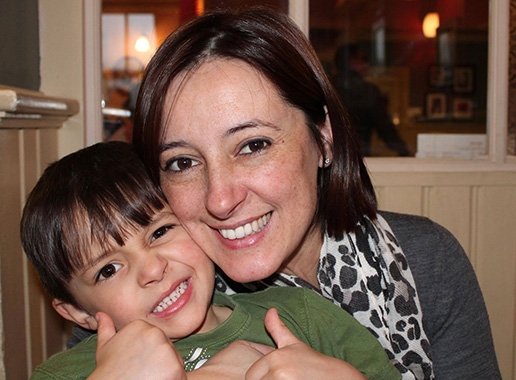- Home
- For Patients
- SCAD Stories
- Andrea
Andrea
Rushing to take her two children to school in January 2016, Andrea ran for a couple of minutes from the car to school. She suddenly felt breathless and had a very strong pain in her chest and upper back.
“It felt as if I was being squeezed from both sides. My throat was really dry and it was hurting to breathe. I started to feel dizzy and shaky; it was a cold day but I was sweating a lot.”
After dropping her children at school, she walked back to the car and sat for a while to see if the symptoms would pass, but they didn’t. She drove home but after having a shower to try and relieve the symptoms, she started to get a “warm rushing feeling from my armpits down to my hands”.
Very scared, Andrea called her husband who told her to call NHS Direct for some advice. When she got through, she was told to calm down and book an appointment with her GP. Unable to get an appointment with the GP that day, she was advised to go to a walk-in centre. When she was seen by a doctor, her blood pressure, temperature and heart rate were all normal, and she was diagnosed with stress, anxiety, being unfit and breathing cold air while running. She was sent away.
Andrea was 44 at the time, slim and healthy and had never suffered from stress or anxiety before.
She went to work and the pain got a bit better, however the next day, she didn’t feel any better and had discomfort in her lower jaw. “I got really scared again,” Andrea said, “but I drove the boys to school. I then went to the medical centre and explained my symptoms and asked to see someone quickly. I was told I could book an appointment for late afternoon.”
After struggling all day at work, she eventually saw a doctor but all readings were normal again. “I was so frustrated at this point and started to cry,” she said. “The doctor told me to go to A&E for a blood test.”
After the first blood test results came back, the tests were repeated. “At this point there was some urgency in the staff’s faces, but nobody explained anything to me,” she said. “At 11.15pm, four hours after I’d arrived, I was asked to lie down and was treated as an emergency. My troponin count was extremely high.”
Troponin is a protein released into the bloodstream during a heart attack so is a simple way to diagnose heart attacks.
Andrea was monitored in hospital overnight and the next day an angiogram was performed and she received a diagnosis of SCAD (spontaneous coronary artery dissection) in the PDA (posterior descending artery).
“I had no idea what that meant,” said Andrea.
“I was in hospital for 5 days. The cardiologist never told me I had had heart attacks – I only found out on the day I was discharged, when a nurse gave me a leaflet called ‘Life after heart attack’. That was a shock. Andrea had no history of heart problems and no risk factors for heart disease.
“I felt completely lost and started to Google spontaneous dissection. The information I found was scary and it didn’t make sense that it had happen to me.”
A couple of days later I had the same symptoms again. “My husband called an ambulance and the paramedics performed some basic tests and the results were all normal. However, because of my history, they took me to hospital.
“They didn’t seem to know what to do with me. Blood tests were done and the troponin count was raised but gradually went down during the next day.”
Andrea was diagnosed with inflammation in and around the heart and was referred to a senior cardiologist.
“While I was in hospital this time, I was seen by the same cardiologist who had treated me before. He made me feel a bit silly by saying that my heart was as healthy as his, and told me to live life to the full as the risk of having another heart attack was the same as to anyone else.
“I tried to tell him what I had read about SCAD online, but he got annoyed and he dismissed what I was telling him, saying ‘since Google came along, everybody is a doctor’.”
A few weeks later Andrea went back to the A&E with chest pain, dizziness and pressure on her neck. She was discharged with some extra medication for anaemia but nothing new was detected.
“I still have odd symptoms such as chest pain and tightness, pain and discomfort in my upper back, racing heart, dizziness, periods of fatigue and pressure on my neck, but I don’t go to the hospital so often any more. I understand by talking to other SCAD survivors that this is part of our new normal,” said Andrea.
“For me, the scariest thing is that the doctors don’t seem to know anything about SCAD and are very quick to give the diagnosis of anxiety and panic attack, which I never had before SCAD.
“I learned to be my own advocate and to push for referrals and adequate treatment. I’ll continue using Google and social media channels to spread the word about SCAD and, hopefully, nobody else will have to go through the same ordeal.”

